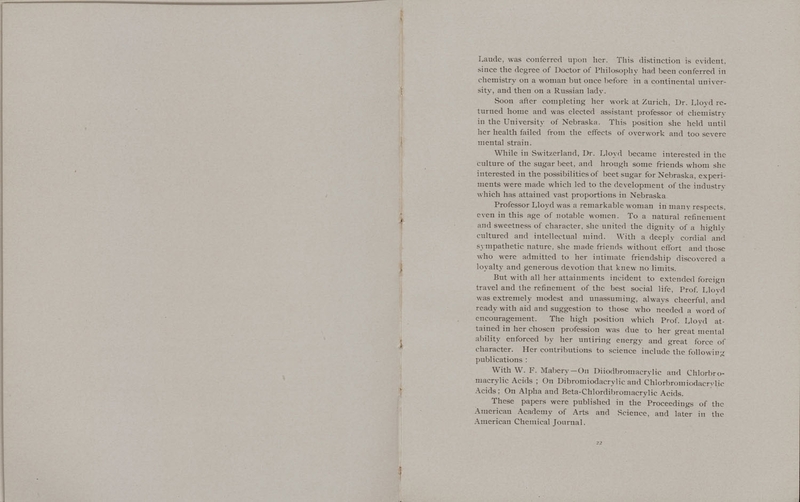In Memoriam - Rachel Lloyd, Ph.D.
Item
-
Title
-
In Memoriam - Rachel Lloyd, Ph.D.
-
Date
-
1900
-
Transcription
-
Laude, was conferred upon her. This distinction is evident, since the degree of Doctor of Philosophy had been conferred in chemistry on a woman but once before in a continental university, and then on a Russian lady.
Soon after completing her work at Zurich, Dr. Lloyd returned home and was elected assistant professor of chemistry in the University of Nebraska. This position she held until her health failed from the effects of overwork and too severe mental strain.
While in Switzerland, Dr. Lloyd became interested in the culture of the sugar beet, and [t]hrough some friends whom she interested in the possibilities of beet sugar for Nebraska, experiments were made which led to the development of the industry which has attained vast proportions in Nebraska[.]
Professor Lloyd was a remarkable woman in many respects, even in this age of notable women. To a natural refinement and sweetness of character, she united the dignity of a highly cultured and intellectual mind. With a deeply cordial and sympathetic nature, she made friends without effort and those who were admitted to her intimate friendship discovered a loyalty and generous devotion that knew no limits.
But with all her attainments incident to extended foreign travel and the refinement of the best social life, Prof. Lloyd was extremely modest and unassuming, always cheerful, and ready with aid and suggestion to those who needed a word of encouragement. The high position which Prof. Lloyd attained in her chosen profession was due to her great mental ability enforced hy her untiring energy and great force of character. Her contributions to science include the following publications:
With W.F. Mabery — On Diiodbromacrylic and Chlorbromacrylic Acids; On Dibromiodacrylic and Chlorbromiodacrylic Acids; On Alpha and Beta-Chlordibromacrylic Acids.
These papers were published in the Proceedings of the American Academy of Arts and Science, and later in the American Chemical Journal.
-
Rights
-
To inquire about usage, please contact Archives & Special Collections, University of Nebraska-Lincoln Libraries. These images are for educational use only. Not all images are available for publication.
-
Is Format Of
-
520100-00105.jpg
-
Identifier
-
520100-00105
-
extracted text
-
Laude, was conferred upon her. This distinction is evident,
since the degree of Doctor of Philosophy had been conferred in
chemistry on a woman but once before in a continental univer-
ty, and then on a Russian lady.
Soon afier completing her work at Zurich, Dr. Lloyd re-
turned home and was clected assistant professor of chemistry
in the University of Nebraska. This position she held until
her health failed ftom the effects of overwork and too severe
mental strain.
While in Switzerland, Dr. Lloyd became interested in the
culture of the sugar beet, and hrough some friends whom she
interested in the possibilities of beet sugar for Nebraska, experi-
ments were made which led to the development of the industry
which has attained vast proportions in Nebraska
Professor Lloyd was a remarkable woman in many respects,
even in this age of notable women. To a natural refinement
and sweetness of character, she united the dignity of a highly
cultured and intellectual mind. With a deeply cordial and
sympathetic nature, she made friends without effort and those
who were admitted to her intimate friendship discovered a
loyalty and generous devotion that knew no limits.
But with all her attainments incident to extended foreign
travel and the refinement of the best social life, Prof. Lloyd
was extremely modest and unassuming, always cheerful, and
ready with aid and suggestion to those who needed a word of
encouragement, The high position which Prof. Lloyd at-
tained in her chosen profession was due to her great mental
ability enforced by her untiring energy and great force of
character. Her contributions to science include the followi
publication:
With W. F. Mabery—On Diiodbromacrylie and Chlorbro-
macrylic Acids ; On Dibromiodacrylic and Chlorbromiodacrvlie
Acids; On Alpha and Beta-Chlordibromaerylic Acids.
These papers were published in the Proceedings of the
American Academy of Arts and Science, and later in the
American Chemical Journal.
�


